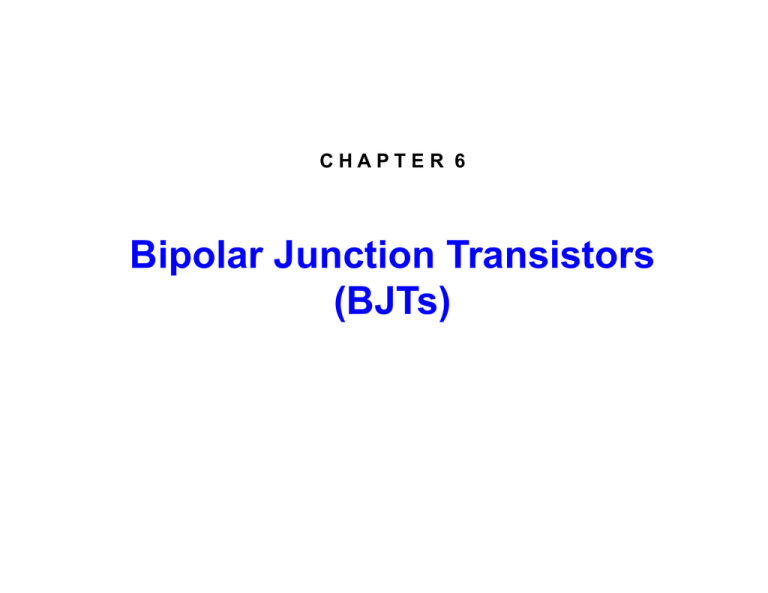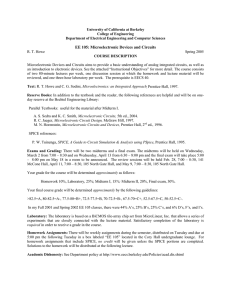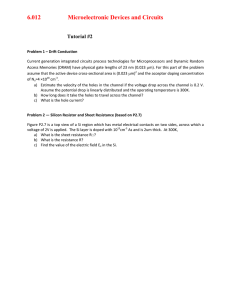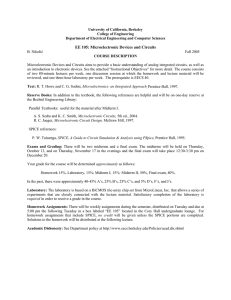BJT_1
advertisement

CHAPTER 6 Bipolar Junction Transistors (BJTs) Figure 6.1 A simplified structure of the npn transistor and pnp transistor. Microelectronic Circuits, Sixth Edition Table 6.1: BJT modes of Operation Mode EBJ CBJ Cutoff Reverse Reverse Active Forward Reverse Saturation Forward Forward Microelectronic Circuits, Sixth Edition Sedra/Smith Copyright © 2010 by Oxford University Press, Inc. Operation of the npn Transistor in the Active Mode Figure 6.3 Current flow in an npn transistor biased to operate in the active mode. (Reverse current components due to drift of thermally generated minority carriers are not shown.) Microelectronic Circuits, Sixth Edition iC I S e vBE / VT iB iC I S vBE / VT i B ( )e iE iC iB iC iE 1 1 = common-emitter current gain Figure 6.5 Large-signal equivalent-circuit models of the npn BJT Microelectronic Circuits, Sixth Edition operating in the forward active mode. Operation in the Saturation Mode forced iC iB saturation VCB 0.4V VBC 0.4V VCEsat VBE VBC VCEsat 0.1 to 0.3V Microelectronic Circuits, Sixth Edition Model npn BJT Operation in the Saturation Mode Figure 6.9 Modeling the operation of an npn transistor in saturation by augmenting the model of Fig. 6.5(c) with a forward conducting diode DC. Note that the current through DC increases iB and reduces iC. Microelectronic Circuits, Sixth Edition Figure 6.10 Current flow in a pnp transistor biased to operate in the active mode. Microelectronic Circuits, Sixth Edition Figure 6.11 Two large-signal models for the pnp transistor operating in the active mode. Microelectronic Circuits, Sixth Edition BJT Current-Voltage Characteristics Figure 6.13 Voltage polarities and current flow in transistors biased in the active mode. Microelectronic Circuits, Sixth Edition Table 6.2: Summary of the BJT Current-Voltage Relationship in the Active Mode Microelectronic Circuits, Sixth Edition Sedra/Smith Copyright © 2010 by Oxford University Press, Inc. Example 6.2. Microelectronic Circuits, Sixth Edition Sedra/Smith Copyright © 2010 by Oxford University Press, Inc. Graphical Representation of Transistor Characteristics Effect of temperature on the iC-vBE, at a constant emitter current, vBE changes by -2mV/0C Microelectronic Circuits, Sixth Edition Sedra/Smith Copyright © 2010 by Oxford University Press, Inc. VCB=-0.4V Microelectronic Circuits, Sixth Edition Sedra/Smith Copyright © 2010 by Oxford University Press, Inc. iC I S e r0 v BE / VT vCE (1 ) VA V A VCE IC VA r0 I 'C I C' I S eVBE / VT Figure 6.18 Large-signal equivalent-circuit models of an npn BJT operating in the active mode in the common-emitter configuration with the output resistance ro included. Microelectronic Circuits, Sixth Edition Sedra/Smith Copyright © 2010 by Oxford University Press, Inc. An alternative form of the Common-Emitter Characteristics Figure 6.19 Common-emitter characteristics. (a) Basic CE circuit; note that in (b) the horizontal scale is expanded around the origin to show the saturation region in Sedra/Smith Copyright © 2010 by Oxford University Press, Inc. Microelectronic Circuits, Sixth Edition some detail. A much greater expansion of the saturation region is shown in (c). IC(max) VCE(max) Microelectronic Circuits, Sixth Edition An Alternative form of the Common-Emitter Characteristics Figure 6.20 A simplified equivalent-circuit model of the saturated transistor. Microelectronic Circuits, Sixth Edition Sedra/Smith Copyright © 2010 by Oxford University Press, Inc. BJT Circuits at DC Cutoff: EBJ: reversed bias, CBJ: reversed bias NPN Microelectronic Circuits, Sixth Edition PNP Sedra/Smith Copyright © 2010 by Oxford University Press, Inc. Active: EBJ: forward bias, CBJ: reversed bias NPN PNP Saturation: EBJ: forward bias, CBJ: forward bias NPN Microelectronic Circuits, Sixth Edition PNP Sedra/Smith Copyright © 2010 by Oxford University Press, Inc. Example 6.3. Find VBB to have: 1. VCE=5V (active mode) 2. Edge of saturation, VCE=0.3V 3. Deep saturation, VCE=0.2V, force=10 Microelectronic Circuits, Sixth Edition Sedra/Smith Copyright © 2010 by Oxford University Press, Inc. Example 6.4 Microelectronic Circuits, Sixth Edition Sedra/Smith Copyright © 2010 by Oxford University Press, Inc. Example 6.5 Figure 6.23 Analysis of the circuit for Example 6.5. Note that the circled numbers indicate the order of the analysis steps. Microelectronic Circuits, Sixth Edition Sedra/Smith Copyright © 2010 by Oxford University Press, Inc. Example 6.6 Figure 6.24 Example 6.6: (a) circuit; (b) analysis, with the order of the analysis steps indicated by circled numbers. Microelectronic Circuits, Sixth Edition Sedra/Smith Copyright © 2010 by Oxford University Press, Inc. Example 6.7 Figure 6.25 Example 6.7: (a) circuit; (b) analysis, with the steps indicated by circled numbers. Microelectronic Circuits, Sixth Edition Sedra/Smith Copyright © 2010 by Oxford University Press, Inc. Example 6.8 Figure 6.26 Example 6.8: (a) circuit; (b) analysis, with the steps indicated by the circled numbers. Microelectronic Circuits, Sixth Edition Sedra/Smith Copyright © 2010 by Oxford University Press, Inc. Example 6.9 Figure 6.27 Example 6.9: (a) circuit; (b) analysis with steps numbered. Microelectronic Circuits, Sixth Edition Sedra/Smith Copyright © 2010 by Oxford University Press, Inc. Example 6.11 Figure 6.29 Circuits for Example 6.11. Microelectronic Circuits, Sixth Edition Sedra/Smith Copyright © 2010 by Oxford University Press, Inc. Figure 6.30 Example 6.12: (a) circuit; (b) analysis with the steps numbered. Microelectronic Circuits, Sixth Edition Sedra/Smith Copyright © 2010 by Oxford University Press, Inc.





